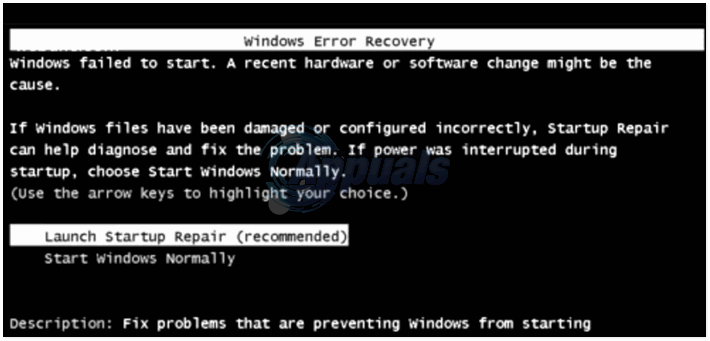Fix: Windows Failed to Start Error on Startup
“Windows has failed to start. A recent hardware or software change might be the cause.”
Waking up to a pc which just does not wish to boot to its Operating process is not anything short of a nightmare which has come into life. There are several distinct mistakes that Windows computers screen when they don't boot in their Operating Systems, and among them is that the"Windows failed to start" error. The entirety of the error message says the following:
"Windows has failed to get started. A recent hardware or software change may be the cause."
The error message display also provides the user with two or three choices which may be utilized to solve the problem (for instance, conducting Startup Repair or beginning Windows normally), but regardless of what choice the user selects, they are sure to go back to the same"Windows failed to start" error message. The cause of the problem could be anything ranging from an untrue or faulty hardware, applications (application or application) or even driver/update which you installed to corrupted boot documents or a problem with your HDD (or SSD).
Considering that the causes of this"Windows failed to start" error message are so varied, so are the alternatives which have shown to work for Windows users who've been influenced by this problem previously. The following are a Few of the Best solutions Which You Can use to attempt to solve this dilemma and successfully boot in Your Operating System:

Method 1: Remove any hardware which you installed and then reboot
When you set up some other hardware (such as printers or printers ) prior to your pc began going haywire and spewing out the"Windows failed to start" error message on startup, then it's fairly probable that the hardware that you installed would be your offender. If that's true, just remove the hardware which you just installed (and rather other non-essential hardware, leaving just the mouse and keyboard attached) and then restart your own PC. If your computer boots to its OS as it needs to, the hardware that you eliminated was really the culprit.
Method 2: Make Sure your computer finds its HDD and can be uninstalled out of it
Restart your pc, and in the very first screen that you view, press the key which will take into its BIOS settings. You'll see this key on your personal computer' user guide and on the very first display, you see if it boots up. After from the BIOS configurations, peruse its own tabs before you discover the Boot priority sequence (or Boot order). Emphasize Boot priority sequence and media Input , and if you find a listing of devices your computer attempts to boot from, ensure your HDD is about the surface of the list.
If your HDD is nowhere to be found among the, start up your computer, and then remove and reseat the SATA or IDE cable linking the HDD into the motherboard (or rather replace it completely ), boot up your computer, get into the BIOS configurations and see if it finds the HDD. If the HDD is not discovered, run diagnostics on it to ascertain whether it has failed or is failing.
If your HDD is on the record but is simply not on the very top of it, then browse the list so the HDD on top and is the computer's original boot device. After doing this, rescue the switch, exit the BIOS and then restart the pc to find out whether the problem was solved.

Method 3: Perform a System Restore
Whether this challenge has been caused by a schedule, application, driver or upgrades up set up, restoring your computer to some point in time until it had been installed must be more than sufficient to repair it.
Add a Windows setup disk or Windows system fix disc to the computer. Restart the computer and boot from the disk.
Note: To boot from the disk, you might need to once again get into your computer's BIOS preferences also, instead of merely taking a look at the boot arrangement to alter it to place your DVD/CD drive as your PC's original boot device. After done, rescue the switch and exit the BIOS configurations and you ought to be asked to press any key to boot from the disk you added whenever your computer starts up.
Pick the Operating System you need to Fix and picked Repair Your PC. Click System Restore. Pick a Restore Point (preferably one which has been created days prior to the problem showed itself). Follow the onscreen directions to commence the System Restore. When the System Restore finishes, restart your pc and check to find out whether your System Restore eliminates this matter.
Method 4: Perform a Startup Repair
Doing a Startup Repair will resolve all problems keeping your personal computer from booting up into its Operating System, which explains the reason why this method has fairly significant odds of repairing this issue for you. To Execute a Start Repair in your pc, you Want to:
Add a Windows setup disk or Windows system fix disc to the computer.
Restart the computer and boot from the disk. Select your language and other tastes and click Next.
If you're utilizing a Windows setup disk you'll be taken to a screen which has an Install Currently button in its center. On this display, click Fix your computer at the bottom left corner. If you're utilizing a system repair disk you'll be taken right to another step. Pick the Operating System you would like to fix. Click Startup Repair. Follow the onscreen directions, start the Startup Repair and once it finishes, restarts your pc to find out if it fixed the issue.

